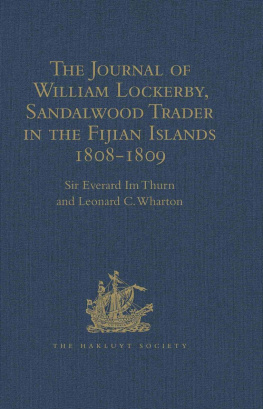First published by Ashgate Publishing
Published 2016 by Routledge
2 Park Square, Milton Park, Abingdon, Oxon OX14 4RN
711 Third Avenue, New York, NY 10017, USA
Routledge is an imprint of the Taylor & Francis Group, an informa business
All rights reserved. No part of this book may be reprinted or reproduced or utilised in any form or by any electronic, mechanical, or other means, now known or hereafter invented, including photocopying and recording, or in any information storage or retrieval system, without permission in writing from the publishers.
Notice:
Product or corporate names may be trademarks or registered trademarks, and are used only for identification and explanation without intent to infringe.
Founded in 1846, the Hakluyt Society seeks to advance knowledge and education by the publication of scholarly editions of primary records of voyages, travels and other geographical material. In partnership with Ashgate, and using print-on-demand and e-book technology, the Society has made re-available all 290 volumes comprised in Series I and Series II of its publications in both print and digital editions. For information about the hakluyt Society visit www.hakluyt.com.
ISBN 13: 978-1-4094-1419-3 (hbk)
WORKS ISSUED BY
COUNCIL
OF
THE HAKLUYT SOCIETY
(1922.)
S IR A LBERT G RAY , K.C.B., President.
S IR J OHN S COTT K ILTII , LL.D., Vice-President.
A DMIRAL OF THE F LEET THE R IGHT HON . S IR E DWARD H OBART S EYMOUR , G.C.B., O.M., G.C.V.O., LL.D., Vice-President.
B OLTON G LANVILL C ORNEY , E SQ ., I.S.O.
M. L ONOWORTH D AMES , E SQ .
W ILLIAM F OSTER , E SQ ., C.I.E.
E DWARD H EAWOOD , E SQ ., Treasurer.
A RTHUR R. H INKS , E SQ ., C.B.E., F.R.S.
S IR J OHN F. F. H ORNER , K.C.V.O.
S IR E VBRARD IM T HURN , K.C.M.G., K.B.E., C.B.
T. A THOL J OYCE , E SQ ., O.B.E.
L IEUT .-C OLONEL S IR F REDERIC G. K INYON , K.C.B.,P.B.A., L ITT .D.
S IR C HARLES L UCAS , K.C.B., K.C.M.G
A LFRED P. M AUDSLAY , E SQ ., D.S C
B RIG .-G EN . S IR P ERCY M. S YKES , K.C.I.E., C.B., C.M.G.
H. R. T EDDER , E SQ .
L LEUT .-C OLONEL S IR R ICHARD C ARNAC T EMPLE , B ART ., C.B., C.I.E., F.S.A.
S IR B ASIL H OME T HOMSON , K.C.B.
S IR R EGINALD T OWER , K.C.M.G., C.V.O.
J. A. J. DE V ILLIERS , E SQ ., Hon. Secretary,
P LATE 1. F IJIANS VISITING H.M.S. P ROVIDENCE , C APT B LIGH [1792]
Reproduced and Printed for the Hakluyt Society by Donald Macbeth.
INTRODUCTION
Till the end of the eighteenth century very little was known of the Fijian islands except from the scanty reports of the few seamen who in exploring the uncharted waters of the South Western Pacific had sighted, and even in very rare cases touched at, one or other of the smaller outlying islands. During the first ten or fifteen years of the following century, however, many British and American ships visited one part of the coast of one of the larger Fijian Islands, for the sake of the sandalwood which accidentally had been found to grow there abundantly. But surprisingly little record of these visits has survived, buried for the most part in the Shipping Gazettes of Australia and the East Indies. By 1815 the sandalwood had been exhausted, and for the next twenty years, though several strangers who had been brought by the sandalwood ships remained therethe so-called beachcombers, the island folk were little visited from outside, unless by an occasional American ship in search of bche de mer. Then, in 1837, Wesleyan missionaries gained a footing in the islands; and about the same time other Europeans began to establish themselves as traders among the native folk.
In 1830, and again in 1841, the French Captain Dumont DUrvile, and in 1845 Commander Charles Wilkes, of the United States Exploring Expedition, published such information as to the history and state of the Fijian Islands as they picked up during their respective visits. But it was the Wesleyan missionaries, Thomas Williams, in 1858, and Joseph Waterhouse, in 1866, who made the first considerable attempt to tell the story of the islands, especially from the first advent of Europeans. The Wesleyans reconstructed their story only from local tradition; but it is rather surprising that they make so little mention of the sandalwood trade. Williams, moreover, is responsible for one erroneous statement, as to the first coming of white men to Fiji, which has been copied by almost all writers on these Islands, and has thus given rise to a misunderstanding now to be corrected by the papers published in this volume. Williams wrote:
About the year 1804 a number of convicts escaped from New South Wales and settled among the islands. Most of these desperadoes lived either on Mbau or Rewa, the chiefs of which allowed them whatever they chose to demand, receiving, in return, their aid in carrying on war.
Two considerable errors were here involved; the arrival of the first whitemen is wrongly described, and it was not to the islet of Mbau nor to the Rewa River, both of which are on the island of Viti Levu, but to Mbua Bay, on the Vanua Levu coast, that the new comers first resorted.
In 1915, my attention was first called, by Mr T. Athol Joyce of the British Museum, to an unpublished manuscript journal in the possession of one of his colleagues, Mr Leonard C. Wharton, also of the British Museum, which was said to have been written in Fiji during the time of the sandalwood trade, therefore, many years earlier than any other known account by an eye-witness of personal experience in those islands. A brief investigation soon showed that the manuscriptsfor there are two very slightly divergent copiesrevealed an interesting and obviously true story of the first entry in historical times of western folk into the islands; and it was a great pleasure to me when Mr Wharton, who is the great-grandson of William Lockerby, the writer of the journal, gave me the chance of editing the papers for the Hakluyt Society, and undertook to assist me as far as necessary in deciphering his ancestors somewhat crabbed handwriting.






![Charles William Chadwick Oman - Wellingtons Army 1809-1814 [Illustrated Edition]](/uploads/posts/book/291191/thumbs/charles-william-chadwick-oman-wellington-s-army.jpg)

